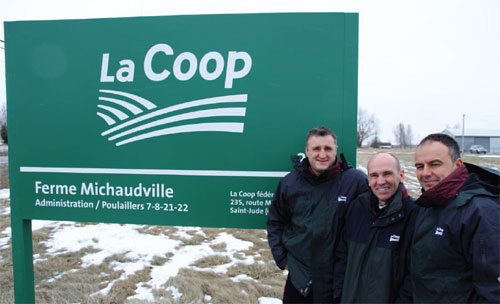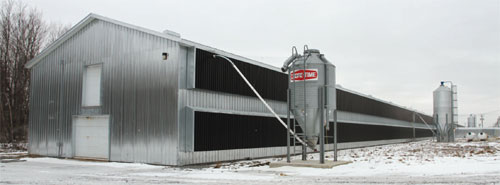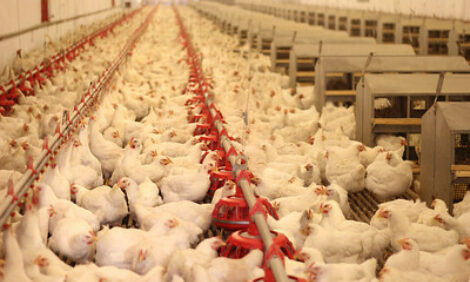



Cooperative Model for Success in Canada
In a country where the pattern of poultry production contrasts with the high level of integration in neighbouring United States, La Coop fédérée is showing how a cooperative approach can provide an alternative route to success, according to an article in the latest issue of Cobb Focus.The organization is a driving force in the economy of the province of Quebec in eastern Canada, and is the country's leading poultry and pig meat processor. Quebec is responsible for 27.5 per cent of the country's annual production of poultry meat.
Formed 90 years ago, La Coop fédérée is owned by its 95,000 members grouped into 106 cooperatives and has an annual revenue of four billion Canadian dollars (C$; US$3.9 billion/€3.08 billion).
As well as meat production, its activities extend from animal feed and grain handling to agricultural merchanting, farm machinery and petroleum.
Its Olymel meat processing and distribution subsidiary is handling more than 1.5 million chickens and 135,000 turkeys a week, along with 160,000 pigs, through plants in Quebec, Ontario and Alberta. International sales to the US, Japan, Australia and some 60 other countries represent almost half of its C$2.1-billion annual revenue.

Recent investment totalling C$6.0 million has been in the hatchery in Victoriaville, Quebec. which was modernized and enlarged in 2010. It has a capacity of 55 million chicks per year, with the facility to add another 10 million a year in the future.
The organization has 15 breeder farms and 69 broiler growing units. Today, 70 per cent of the broilers are Cobb500 slow feathering – the breed they introduced to their market in 1998.


Competing in a market where chicks are sold to independent broiler growers, they wanted a breed with strong broiler characteristics and their customers are benefiting from the consistent performance of the Cobb500.
"The broiler performs very well," says Sylvain Lefebvre, first director of the poultry division. "The bird can be pushed and adapted to Canadian standards. The feed conversion and weight gain are exceptional – all backed up by excellent after-sales service."
La Coop fédérée's own breeder farms are also achieving top results, with the most recent sold flock survey of Cobb Canadian customers showing it had the best results on total eggs for the Cobb500 slow feathering and the third best overall for slow and fast feather combined.
Philippe Dufour, sales representative for Cobb-Vantress, comments: "We really work in partnership with La Coop fédérée to make sure they achieve the breed's full genetic potential all the time.
"With the genetic progress giving them an improved product year after year, their technical team members work very closely with our people to make sure the Cobb500 is well adapted to their standards so that it proves a win-win situation for them, their producers and Cobb.
"After all, they look to attain the best performance flock after flock and Cobb is giving them just that."
"It is great to work with a group that is so dedicated in striving to achieve excellent results," adds David Engel, Eastern Canada technical service representative for Cobb.
La Coop fédérée also has Sasso breeders for the speciality market in the north east of the US and for this developing new market in Canada. It was Cobb who introduced the organization to Sasso following the cooperation between Cobb Europe and the French breeder in developing products for niche markets for slower growing chicken.
| La Coop fédérée broiler results during 2011 | |||||
| Age (days) | Total mortality (%) | Weight (kg) | FCR | ADG | |
|---|---|---|---|---|---|
| Female <2 kg | 34.1 | 1.51 | 1.850 | 1.629 | 54.2 |
| Female >2 kg | 38.2 | 2.13 | 2.258 | 1.720 | 59.1 |
| Male >2 kg | 36.4 | 2.27 | 2.376 | 1.653 | 65.4 |
| As hatched | 38.8 | 1.35 | 2.350 | 1.698 | 60.7 |
| Results from top 25 per cent of flocks. Total number of birds in excess of 1.5 million. | |||||
The Canadian market is unusual in being regulated by a supply management system through quotas.
"The Chicken Farmers of Canada administers the national regime, using a 'bottom up' approach to determine level of national supply," says Philippe Dufour. "They take into account what are deemed the reasonable needs of downstream players.
"Provinces each submit requests for a specific volume of production, and the CFC then determines whether the aggregate represents needs of the Canadian market for the quota period."
In the province of Quebec, all day-old chicks are sold sexed, this is not the pattern nationally; in neighbouring Ontario more of the chicks are sold as-hatched and elsewhere across the country the demand is for all as hatched.

Average annual per capita chicken consumption in Canada is 31.1kg, which puts the country in the top 10 but still a long way short of the US appetite for chicken. Most of the chicken is bought as whole birds, cut-up or tray packs, with further processed products accounting for around 25 per cent.
In Quebec, there is a big market for rotisserie-style chicken and throughout Canada, also a growing consumer trend towards healthier product reared without antibiotics.
January 2012








